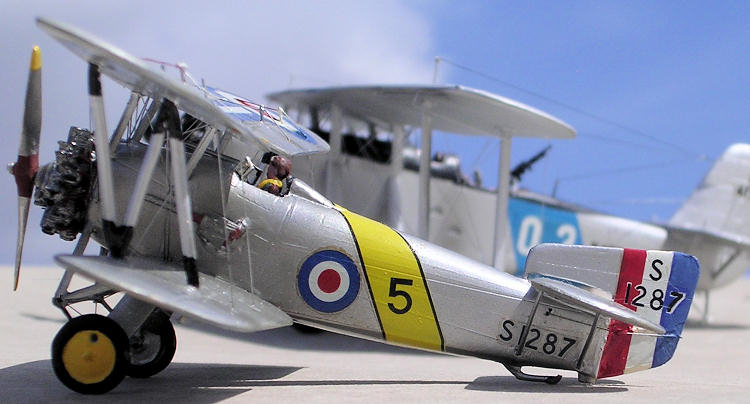
Aeroclub 1/72 Fairey Flycatcher
| KIT #: | ? |
| PRICE: | £6.40 |
| DECALS: | One Option |
| REVIEWER: | Carmel J. Attard |
| NOTES: | Short run with white metal parts |

| HISTORY |
In 1922
the Air Ministry Specification 6/22 called for a Naval single seat fighter to
replace the Nieuport Nightjar, in carrier borne service. Alternative landplane,
floatplane and amphibious configuration were required. The power plant was to be
based on one radial engine, for which the 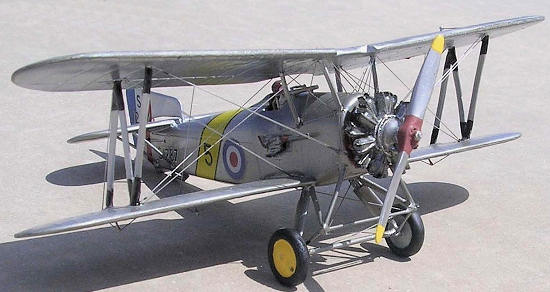 were the
Fairey Flycatcher I and the Parnell Plover, each being ordered to the extent of
three prototypes. Parnell later built 10 production examples of its Plover but
though this aircraft looked far superior in looks to the angular Flycatcher, it
was no match in other respects to the Fairey Biplane and lasted barely a year in
Naval service. The first prototype of the Flycatcher, with a 400hp Jaguar II
engine made its maiden flight on the 28th November 1922 as a
landplane and was subsequently er-engined with identically rated Jupiter IV
engine for the 1923 RAF display.
were the
Fairey Flycatcher I and the Parnell Plover, each being ordered to the extent of
three prototypes. Parnell later built 10 production examples of its Plover but
though this aircraft looked far superior in looks to the angular Flycatcher, it
was no match in other respects to the Fairey Biplane and lasted barely a year in
Naval service. The first prototype of the Flycatcher, with a 400hp Jaguar II
engine made its maiden flight on the 28th November 1922 as a
landplane and was subsequently er-engined with identically rated Jupiter IV
engine for the 1923 RAF display.
Like
most other Fairey aircraft the Flycatcher I had the camber-changing mechanism,
which gave an extremely short take-off and the ability to fly into carrier decks
without using arrestor wires. The Flycatcher also had a short span that proved
to be another advantage in carrier operations. It was also easy to be taken down
in the lift without any need to wing folding. The first unit to equip with
production version was No 402 Flight of the Fleet Air Arm in 1923, and it
continued to replace earlier types on all the aircraft carriers and also as an
aircraft turret platform fighter in some capital ships. The total production
including three prototypes amounted to196. It continued to serve the flight
until 1934 where the last aircraft floatplane, operating with No 406 Flight
attached to the
The Flycatcher was
extremely popular with the pilots who flew it. It was very responsive and strong
in spite of its mixed wood and metal construction under a covering largely of
fabric and could be dived vertically at full throttle. It was aerobatic even as
floatplane form. There were no export sales, no genuine aircraft survived,
although a full scale replica has been built in
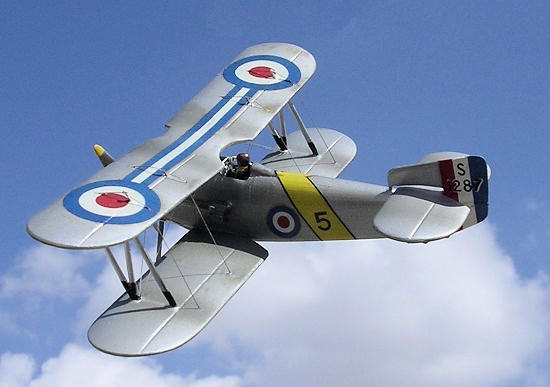 The
Fairey Flycatcher has good connections with aviation in
The
Fairey Flycatcher has good connections with aviation in
Details on the
occasions when Flycatchers came to
Unit
From carrier
Date in
Date out
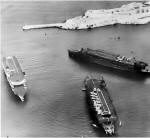 402
Flight HMS Eagle
June 1924
April 1929
402
Flight HMS Eagle
June 1924
April 1929
403
Flight HMS Hermes
Nov 1924
August 1926
401
Flight HMS Eagle
Febr 1926
Septem 1926
407
Flight HMS Courageous
June 1928
August 1929
404
Flight HMS Courageous
Septe 1928
August 1929
402
Flight HMS Eagle
June 1929
May 1931
405
Flight HMS Glorious
July 1930
Septem1932
406
Flight HMS Glorious
July 1930
January 1932
408
Flight HMS Glorious
July 1930
March 1931
| THE KIT |
The Flycatcher was a stubby little fleet biplane of the 1920s era and Aeroclub was the first to produce it in 1/72 scale as the type was only issued to 1/48 scale earlier under two different suppliers label in injected form. The Aeroclub kit is a mixture of gray plastic with white metal parts. The metal parts are the engine, propeller, interplane and undercarriage struts, fuselage guns, control column and seat. The kit is small and so is the cockpit opening making the interior practically hidden and so is the interior detail. A reasonably good decal sheet is issued for one aircraft.
| CONSTRUCTION |
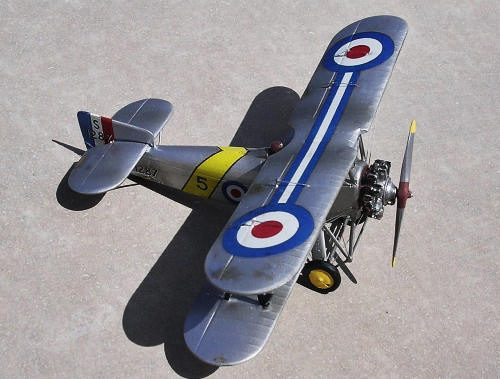 The
instruction is easily followed and leads to a rapid assembly of the airframe.
The tail plane may require thinning in section so that it leaves a gap visible
between the tail plane and the fin/rudder unit and fuselage just like the real
thing. So it is suggested to refer to illustration and photos of the aircraft.
Care is taken when placing the upper wing on the already fixed lower wings. It
is common practice to fix the outer struts first, then lower and fix the upper
wings and when set and well secured, one can then trim and fix the fuselage
short struts. I added rigging using the invisible thread method involving
passing the thread through small-predrilled holes on wings and fuselage. One may
resort to represent rigging with steel wire, which can save a lot of time but in
the end it is a rather fragile kit. My kit came without a windscreen and no
operating aileron and elevator horns supplied. I had to add these from shaped
scrap plastic.
The
instruction is easily followed and leads to a rapid assembly of the airframe.
The tail plane may require thinning in section so that it leaves a gap visible
between the tail plane and the fin/rudder unit and fuselage just like the real
thing. So it is suggested to refer to illustration and photos of the aircraft.
Care is taken when placing the upper wing on the already fixed lower wings. It
is common practice to fix the outer struts first, then lower and fix the upper
wings and when set and well secured, one can then trim and fix the fuselage
short struts. I added rigging using the invisible thread method involving
passing the thread through small-predrilled holes on wings and fuselage. One may
resort to represent rigging with steel wire, which can save a lot of time but in
the end it is a rather fragile kit. My kit came without a windscreen and no
operating aileron and elevator horns supplied. I had to add these from shaped
scrap plastic.
| COLORS & MARKINGS |
The kit is first given a coat of Humbrol silver
mixed with a few drops of clear gloss varnish and allowed to dry for some 4
hours before the decals issued with the kit are first trimmed and applied. These
represent a Flycatcher of 405 Flight from HMS Glorious and that was the same
Flight that used Hal Far airfield, in the south of Malta whenever the carrier
put the aircraft ashore during visit to Valletta Grand Harbour.
| CONCLUSIONS |
| REFERENCES |
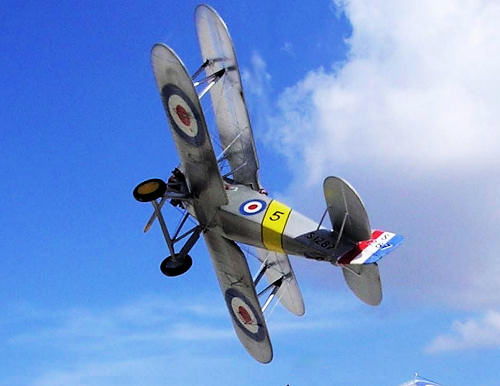 -T he
Encyclopedia of World Aircraft by Paul Eden & Soph Moeng.
-T he
Encyclopedia of World Aircraft by Paul Eden & Soph Moeng.
2
-
Military Aviation in
3
- Fairey Flycatcher Air publication 1078 Air
Ministry 1924.